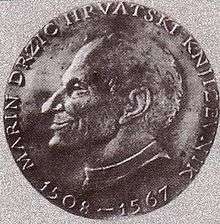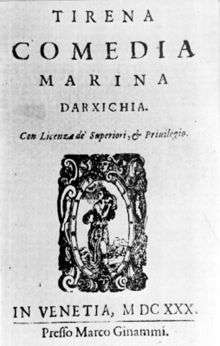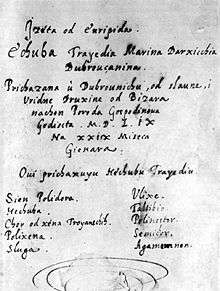Marin Držić
Marin Držić (Croatian pronunciation: [mâriːn dř̩ːʒitɕ]; also Marino Darza or Marino Darsa; 1508 – 2 May 1567) was a Croatian[1][2][3][4][5][6] writer from Republic of Ragusa. He is considered to be one of the finest Renaissance playwright and prose writers of Croatian literature.
Marin Držić | |
|---|---|
 | |
| Born | 1508 Republic of Ragusa (modern-day Croatia) |
| Died | 2 May 1567 (aged 59) Republic of Venice |
| Occupation | Writer |
| Period | Renaissance |


Life
Born into a large and well to do family (with 6 sisters and 5 brothers) in Dubrovnik, Držić was trained and ordained as a priest — a calling very unsuitable for his rebel temperament. Marin's uncle was another famous author Džore Držić. Ordained in 1526, Držić was sent in 1538 to Siena in Tuscany to study the Church Canon Law, where his academic results were average. Thanks to his extroverted and warm personality, he is said to have captured the hearts of his fellow students and professors, and was elected to the position of Rector of the University. Losing interest in his studies, Marin returned to the Dubrovnik Republic in 1543.
Here he became an acquaintance of Austrian adventurer Christoph Rogendorf, then at odds with Vienna court. After a brief sojourn in Vienna, Držić came back to his native city. Other vagabond exploits followed: a connection with a group of Dubrovnik outlaws, a journey to Constantinople and a brief trip to Venice. After a career as an interpreter, scrivener and church musician, he even became a conspirator. Convinced that Dubrovnik was governed by a small circle of elitist aristocracy bent to tyranny, he tried to persuade in five letters (four of which survive) the powerful Medici family in Florence to help him overthrow the government in his home town; they did not respond. Marin died suddenly in Venice on 2 May 1567. He was buried in the Church of St. John and Paul.
Works
Držić's works cover many fields: lyric poetry, pastorals, political letters and pamphlets, and comedies. While his pastorals (Tirena, Venera i Adon and Plakir) are still highly regarded as masterful examples of the genre, the pastoral has, as artistic form, virtually vanished from the scene.
However, his comedies are among the best in European Renaissance literature. As with other great comedy writers like Lope de Vega, Ben Jonson or Molière, Držić's comedies are full of exuberant life and vitality, celebrating love, liberty and sincerity and mocking avarice, egoism and petty tyrants — both in the family and in the state. His best-known comedies include:
- Pomet (1548 or 1553) - some historiographers argue that Pomet is indeed Marin's oldest play, his debut, while others disagree. The fact that it's lost makes it harder to classify it.
- Novela od Stanca (1550)
- Dundo Maroje (1551 or 1556) - arguably Marin's most famous play. It was also played in some international theatres.
- Skup (1554) - thematically similar to Plautus' Aulularia and Molière's The Miser
The gallery of young lovers, misers, cuckolds, adventurers, senile tyrants, painted with the gusto of buoyant idiom that exemplifies richness of the Croatian language in the Renaissance period has remained the pillar of South Slav high comedy theatre ever since.
Legacy
Since its independence Croatia has awarded the Marin Držić Award for dramatic work.[7] The Croatian Parliament also declared 2008 the Year of Marin Držić, as it is the 500th anniversary of his birth.[8] An avenue in Zagreb is named after him. In Draškovićeva street (centre of Zagreb) there is a scenical stage named after Marin's nickname Vidra.[9] Nicknames are given for various reasons. In Croatian the word vidra can also point to a person who is perfidious and resourceful.[10]
See also
| Wikisource has original text related to this article: |
| Croatian Wikisource has original text related to this article: |
References
- Comparative Literature. 11-12. University of Oregon. 1959. p. 347.
- Dubrovnik: A History. Saqi Books. 2006. p. 260. ISBN 0863569595.
- McGraw-Hill Encyclopedia of World Drama. 1. McGraw-Hill. 1984. p. 197. ISBN 978-0070791695.
- Kudělka, Viktor (1983). Malý labyrint literatury: Pro čtenáře od 12 let. Albatros. p. 125.
- Stewart, James; Facaros, Dana; Pauls, Michael (2005). Croatia and the Adriatic. Cadogan Guides. p. 132. ISBN 1860111920.
- Rough Guides (2016). Dubrovnik and Around (Rough Guides Snapshot Croatia). Penguin. ISBN 0241277965.
- Year of Marin Držić Archived 10 January 2008 at the Wayback Machine
- Držić's Year Archived 20 May 2008 at the Wayback Machine
- "Scena Vidra". Archived from the original on 4 October 2014. Retrieved 10 January 2012.
- http://hjp.srce.hr/index.php?show=search_by_id&id=f19uXxN1&keyword=vidra
| Wikimedia Commons has media related to Marin Držić. |